Preface for Chinese Translation
Since th在 writing of book, OpenCV is now actively supported by Willow Garage
(http://www.willowgarage.com). a robotics research institute located in Menlo Park,
California. During the time when OpenCV had less support, Shiqi Yu helped out by
producing a Chin在se translation of OpenCV documentatìon. It is therefor fítting that
Shiqi has continued on to produce the Chinese 主ranslation of this book. The Chinese
translation timing is also nicely aligned with the new rele在se 2.0 of OpenCV ín
Sept非mb衍 2009. You can fínd links to current information on OpenCV at the main wiki
page at ht伊 :Ilopencv. willowgαrage.com which
the detailed page at
ht伊:/Iopencv. willowgarage.comlwikiIFullOpenCVWiki. The new OpenCV releases are
detailed in http://opencv.willowgarage.com/wiki/Welcome/lntroduction得Announcements.
links
to
Applications for computer vision and machine perception are growing rapidly. For
example, many people are familiar with' face detection now available on consumer
cameras. Many of those face detection techniques are adapted from the face detection
algorithms developed in OpenCV. B时, many people are not aware of just how
important comput在r vision already
is
manufactured thes号 days without making use of video inspection equipment, camer剖
now monitor fruits and vegetables for blemishes, make sure that the labels on products
are put on in the right plac号,飞存在tch to make sure cloth has no flaws , or that each pixel
works on an LCD screen and much more. Many of thes缸 applications make us 在 of
OpenCV routines, many such systems ar在 deployed in China.
for manufacturing. Almost nothing
is
Computer vision 在lso has growing uses in monitoring and safety. Some people 在re
aware of security cameras in airports and train stations, but fewer people know th以
cameras are also increasingly used to monitor mine equipment, prev 告nt drownings in
swimming pools and watch traffic flow and accidents onfreeways. OpenCV, wìth its
\i cen白, encourages commercial use and so is deployed on many of these
BSD
monitorìng systems. When you search th在 web , many of 住在 image processíng routines
run by Google make 泣se of OpenCV. These uses r在nge from helping stitch satellite and
airplane ìmages together in Google Earth and Google Maps, but also tl{… stitch street
scenes together and align the imagery with laser sc拍 s in Google Street View.
�
,.,..
Computer vision has many uses on th牵 Web , such as in the Video Summary produced
by Video Sur叹http://w附v. videosurf coml)or for image retrieval by 在11 the m我jor search
engines. There is a positive feedback here because the more images there are on the
web, the more training data becomes avai1able such as LabelMe(ht伊 ://labelme.csail.
mit.edu/ datα bases)or Tiny Images(ht伊从伊eople. csail. mÌ!. edu/torralba/tinyimages/
collection). Additional1y, more and more researchers are using Amazon's Mechanical
Turk service(https://www.mturk.com/mturk/welcome}to
images databases for
pennies per image 在nd tools are appearing to make such labeling tasks easier to run
(http:牛 r. wi/lowgarage.com/wiki/ROS/mturk). The training data from these databases
and services helps improve computer vision algorithms.
label
By coincidence, both authors of the OpenCV book now work in robotics where sensor
perception Îs the main obstacle to enable wide deployment of robotics. Robots wilI be
useful for elder1y care, for agriculture, for services and for manufacturing. Robots ha可s
been doing well at navigation and mapping(ht伊 ://ww¥毛人youtube.com/watch?v=
qRrMHa06NpE)but the real key to unleashing a mobile robotics in出stry is perception
for manipulation. Robots need to be able to see objects reIiably in order to manipulate
and build things. There is stilI much work to do to make perception re Ii abl缸, and that is
to col1ect the best work of the top people in
one of the reasons why OpenCV is open -
order to enable se告ing machines. R在cently there have been many advances in mobile
manipulation(ht伊 ://Wli几1人youtube.com/watch?v口 OS2dc…B-6Kg)but much more work
remains to be done. Fortunately, OpenCV is keeping up and now does a major release
every 6 months with dai1y improvements available from the source code repository
(http://sourc矿orge.net/scm/?type=svn<.是group_id口22870).
1 thank Shíqi Yu and Ruizhen Liu for their translation of this book. People who work in
open source do their work for all of humanity and not for any specific co边往try ,
company or group. OpenCV was designed to 在ccelerate human knowledge and
capabiIity by making advances in knowledge 在vailable to everyon号. This is an
optimistic ¥ iew of humanity but it depends on contributions back. We encourage top
scientists and deγelopers in China to le在rn OpenCV and to contribute their advances
back to the effort.
Gary Bradski
Senior Scientist, Willow Garage
Consulting Professor, Stanford University, CS Dept.
g在rybradski 也gmai l. com
September 2009
�
阳trJ号
学习 OpenCV
(中文版)
Gary Bradski Adrian Kaehler 著
于仕琪刘瑞棋译
。要 REILLY@
Be扩ing. Cambridge. Farnham • IGδln. Sebastopol. Ta专7ei. To妙。
。, Reilly Media, Inc. 授权清华大学出版社出版
清华大学出版社
北京
.,.....,;,-~
国
�
内容简介
计算机视觉是在图像处理的基黯上发展起来的新兴学科. OpenCV 是…个开源的计算机挠觉
是英特尔公司资爵的两大器像处理科器之…。它为自像处理、 a模式识别、三维重建、物体跟
踪、机器学习和线性代数提供了各种各样的算法。
本书画 OpenCV 发起人所写,站在二t钱开发人员的角度琦混俗易锚的语言解释了 OpenCV 的
缘起和计算辑视觉3基础结构,演示了如何蹲 OpenCV 和现有的自由代码为各种各样的机缔造好编
程,这些都有助于读者迅速入门并渐入佳境,兴趣盎然地深入探索计算机提党领域。
本书可作为借息处理、计算挠、机器人、人工智能、遥感器像处理、认知神经科学等有关专
业的高年级学生或研究生韵教学用书,也可供招关领域的研究工作者参考。
Copyright @ 2008 G被y Bradski and Adri在n Kaehler. AI1 rights reserv时,
Authorized. Simplified Chinese translation editio珑, by 0'这.eilly Media与 Inc. ,. is published by Tsi吨hua
University 如ωs, 2009. Authorized translation of the original English edition, 2008 O'Rei11y M创 ia,
Inc., the owner of all rights to p泣blish and sell the same.
All rights reserved inch品ding the rights of reproduction in whole or in part in any form.
本书之英文原版自 O'Reilly Media, lnc. 于 2008 年出版。
本书中文简体版由。'Rei IlyMedia, Inc. 接权清华大学出版社出版 2009 年出殿。此翻译烛的出版
和销售得到出随校和销售权的所有者…--o'Rei Ily Media, Ino. 的许可。
版权所有,未经书菌许可,本书的任何部分和全都不得以任何形式复醋。
北京市版权局著作权合同登记号 图字 01-2009-5150
本书封离黯有清华大学出版社防伪标签,无标签者不得销售。
版权所有,侵权必究。侵权举拨电话: 010-臼7829嚣9
图书在接摘自 (CIP)数据
学习 Qpe'fçy(中文版.)[(秉)布拉德斯基(Bradsld, G), (美)克勒。王aehle几A.)著:子仕琪,却瑞祯译.
…北京 z 清华大学出版社, 2009.10
书名·原文Learning 句enCV
ISBN 978蝙7-302-20993δ
学… II.①布…@克…@子…@刘… m. 图像处理…应用软件 N. TP39 1.41
中国版本翻书馆 CIP 数据核字。009)第 151959 号
13701121933
责任编辑 z 文开琪
纣商设计 Ellíe Volckhausen 张健
版式设计 ε 北京东方人华科技有限公司
责任印制 g 李红英
出版发行"清华大学出版社
址 g 北京清华大学学研大厦 A JÆ:
地
邮编 100。在4
http://www.tup.com.cn
拉总机: 010-62770175 鄙鹅: 010-62786544
投稿与读者服务: 010ω62776969 仲service@tup. tsi吨hua. edu.cn
质量最反馈 010币 62772号 15 , zhiliang@tup. tsinghua. ed认 cn
印尉着:清华大学印刷厂
装订者 2 北京市密云县东文奇事j 本装订厂
经
开
版
印数 1-4000
定价 75. ∞元
销:全国新华书店
本 178 X 233 印张: 39.5 字数: 769 千字
次 2009 年 10 月第 1 版
印
次 20的年 10 月第 1 次印麟
本书如存在文字不清、靠着印、缺页、倒页、脱页等印装质量问题,请与清华大学出版社出版
部联系调换@联系电话 (010)62770177 转 3103
产品编号: 029292-01
�
目录
击舰前言.………………..副……………..越箱..............……·每............................ VI
译者序.. .. .. .. .. .. .. .. .. .. ,. .. .. .. .. .. .. .. .. .. .. .. .. .. .. .. .. .. " " • .. " .. .. .. " • .. .. .. .. .. .. .. .. ~ ., .. .. .. .. .. .. • .. • .. .. .. • • .. .. .. * ,. .. .. .. .. .. .. .. .. .. .. .. • .. .. .. .. .. .. .. • • .. .. ..刻
写在茹丽的话............……….......,.榻………….......…….............".......将·‘...... XIII
前宵 ……....…...............…编......................喻........………… ......................XV
第 1 章概述................................"..............‘……..细........................蜀 ..............1
什么是 OpenCV …… .........4." ~......... ................................….........…..................................;...............1
OpenCV 的应用领雄.篝............ ....................................................... ........................................~.......................... ..............蕴..攀…..... 1
什么是计算机操觉.. ........ ~................... ..….‘…………………………..……………·剥…… .....................2
OpenCV 的越源………........….............毫............盔....... ............................................. O*......~.................. ………..稽 6
下载和安装 0严nCV ...................................................…........………...…唱 .................8
通过 SVN 获取最蔽的 OpenCV 代盹……..…….......….................................…... .... ...11
多 OpenCV 文档................... •. .... ...... ~............ .......叶'葡萄 .............................w. …………..凰…… ........12
0μnCV 的结构和内容.......... ~. _.... . ....黯稽. .. .. . ... . *." ~.... •• .•• ••• ~‘……………… .........................14
移植性到............~.. .……..…. ~. . . . . . . . . . . . * • • • • • • • • • • • • • • • • • • • • .…...................……..........................16
.....................…. ...••••.•••.••..•. ~'.,..... *.......... ... ... .. ......... ......确................ ••••••• ••• •• ~.‘....刊
练}::]
第 2 意 OpenCV 入门....盔..................鹏…民…·晕………......翩.......................渺 ....18
开始准备....................................................................……… ...................................18
初试牛丑…一-显示器像~.. ~.. . .…...............…·…........................................................19
第工个程序…←-播放 AVI 视频....... .. . .. ...... . . . . . ....... ...... . .. ....... ..... ... ~....... ...... ... .. ..朱 ..21
视频播放控制.........................… .............................................................................23
一个简单的变换................................………….......................……….........................压
…个复杂一点的交换.............………......……....…… H·H·-H·H·-H·H·-UH·H·-1..H·a·-… 28
�
�
�
�
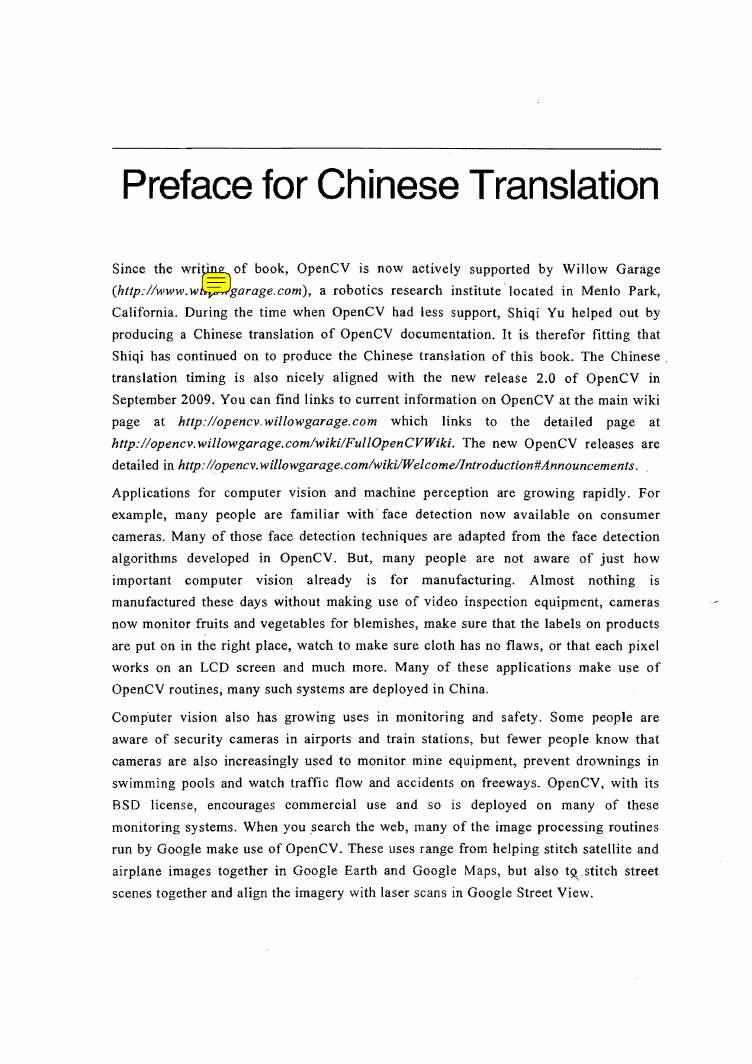
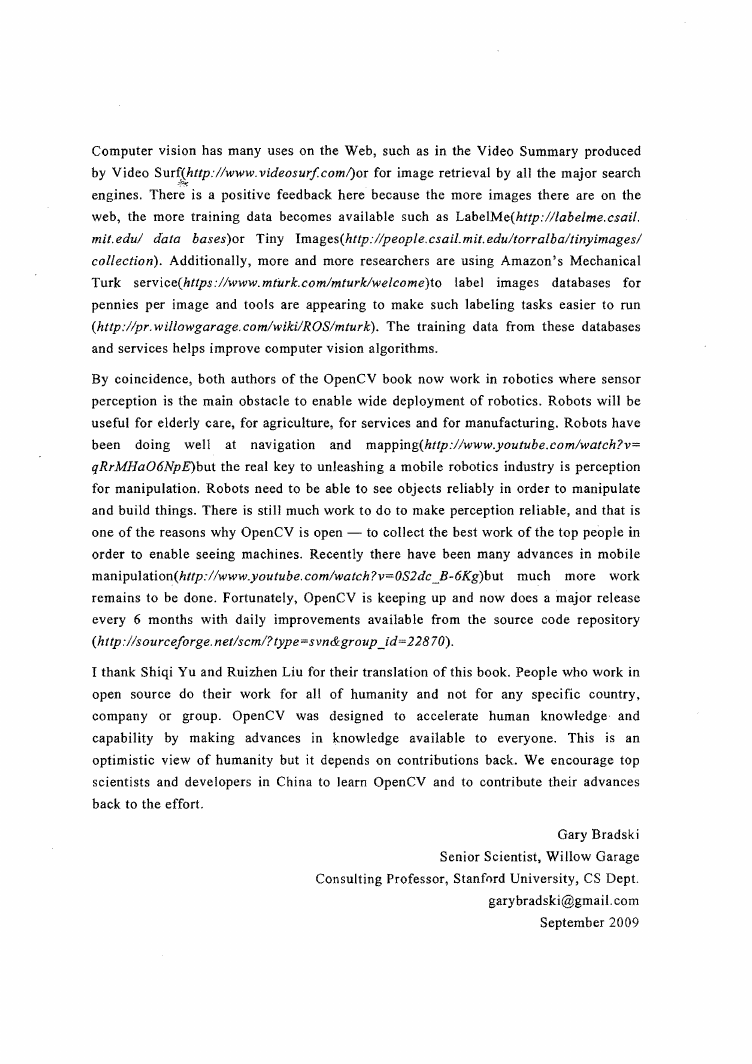
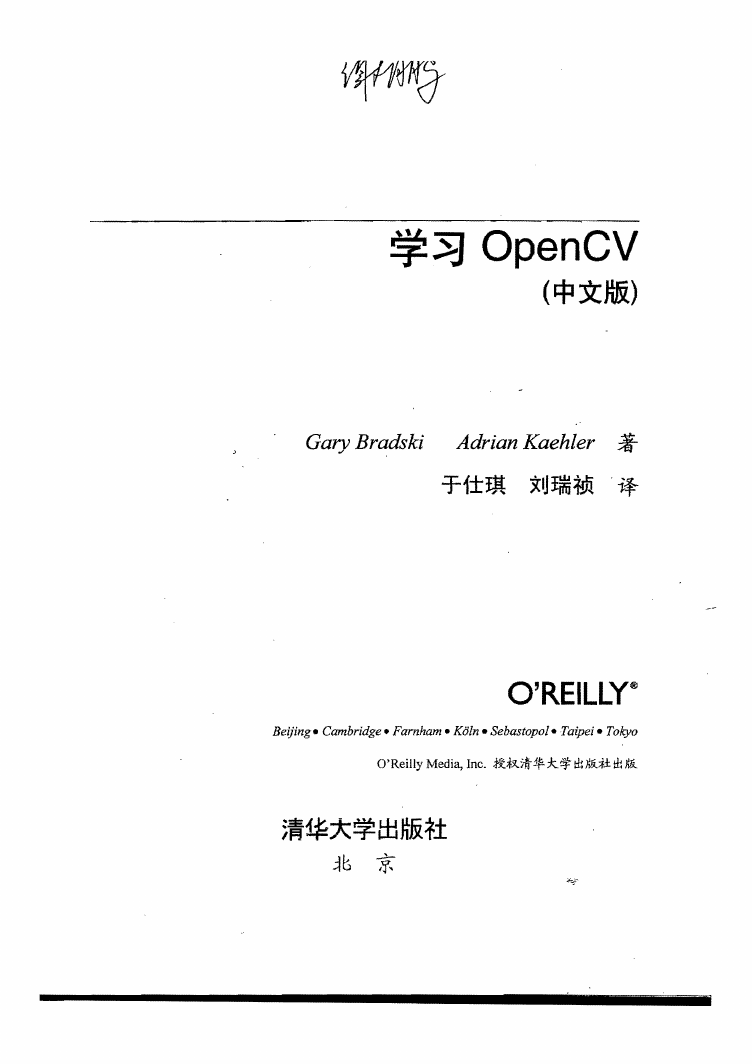
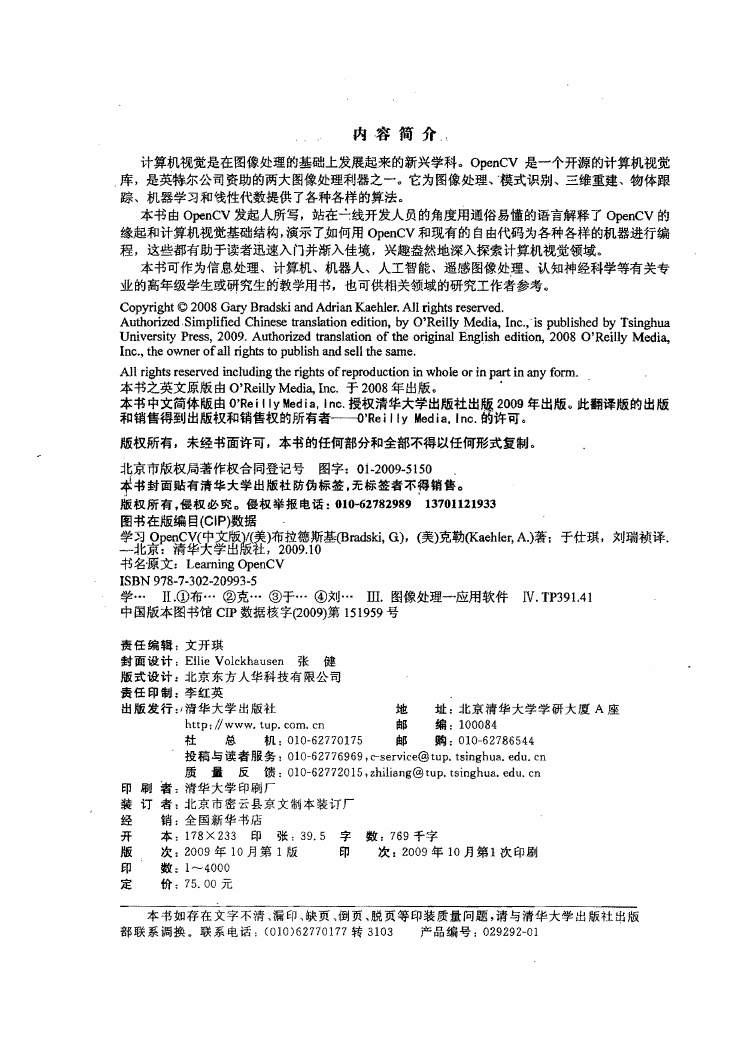
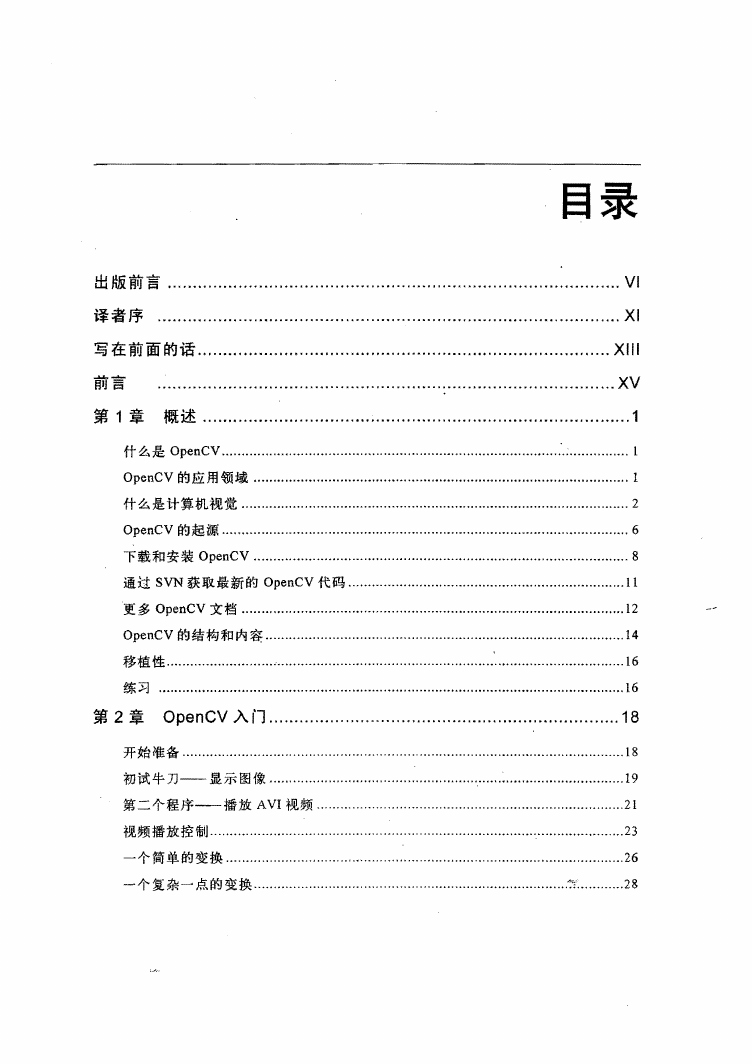
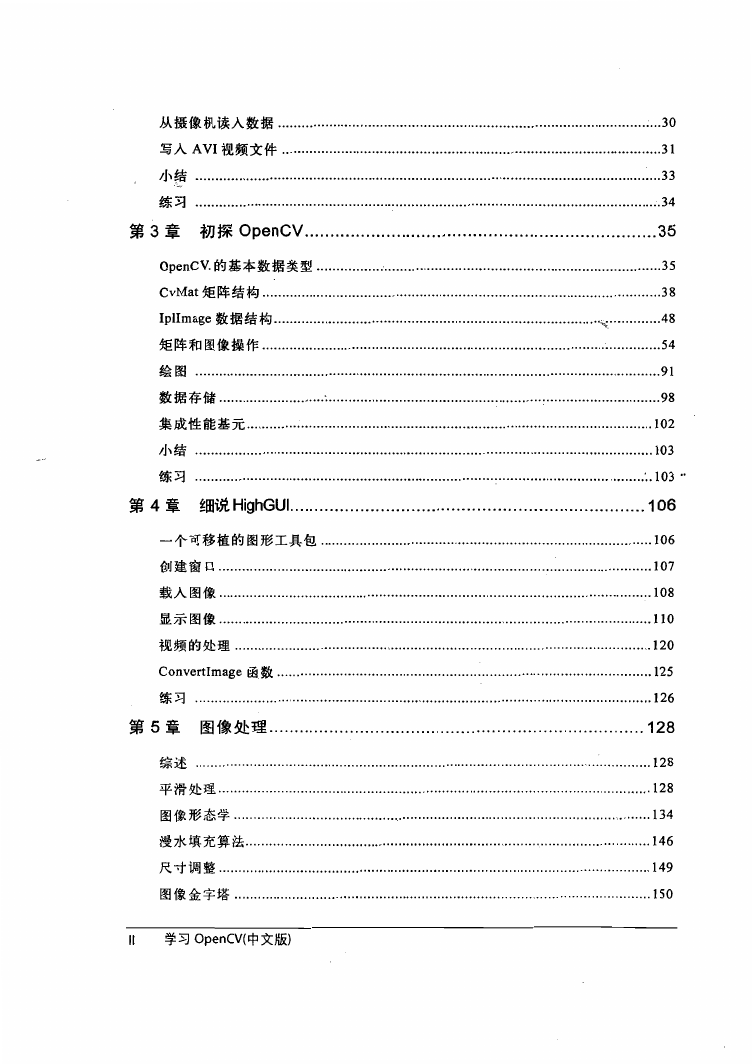
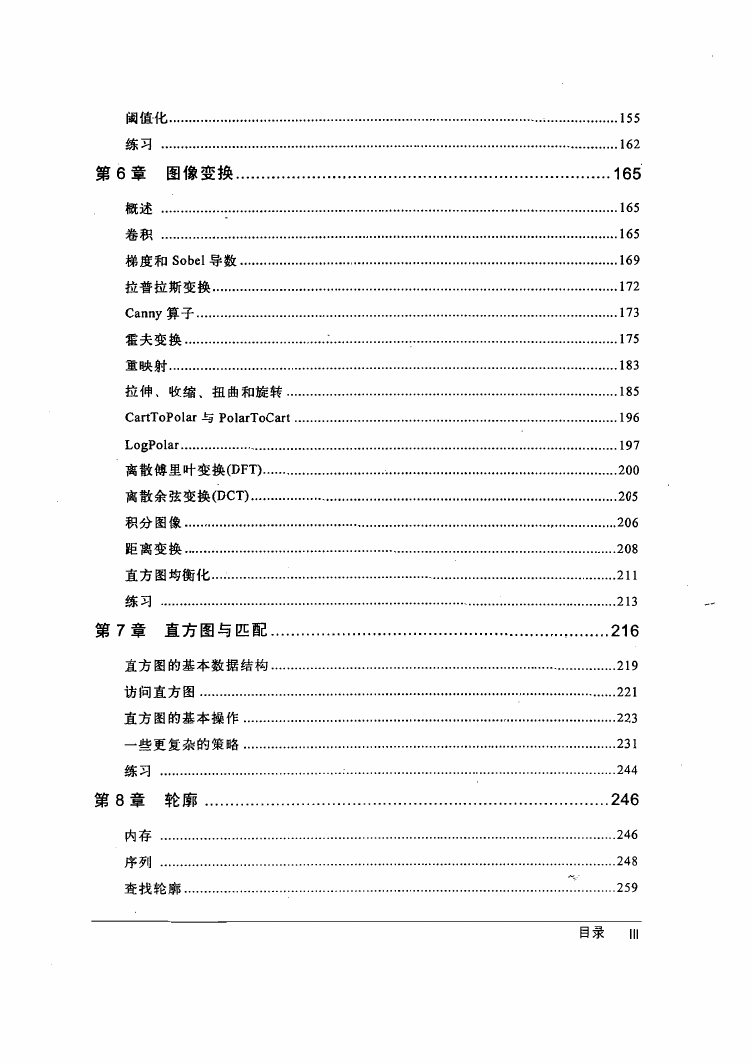
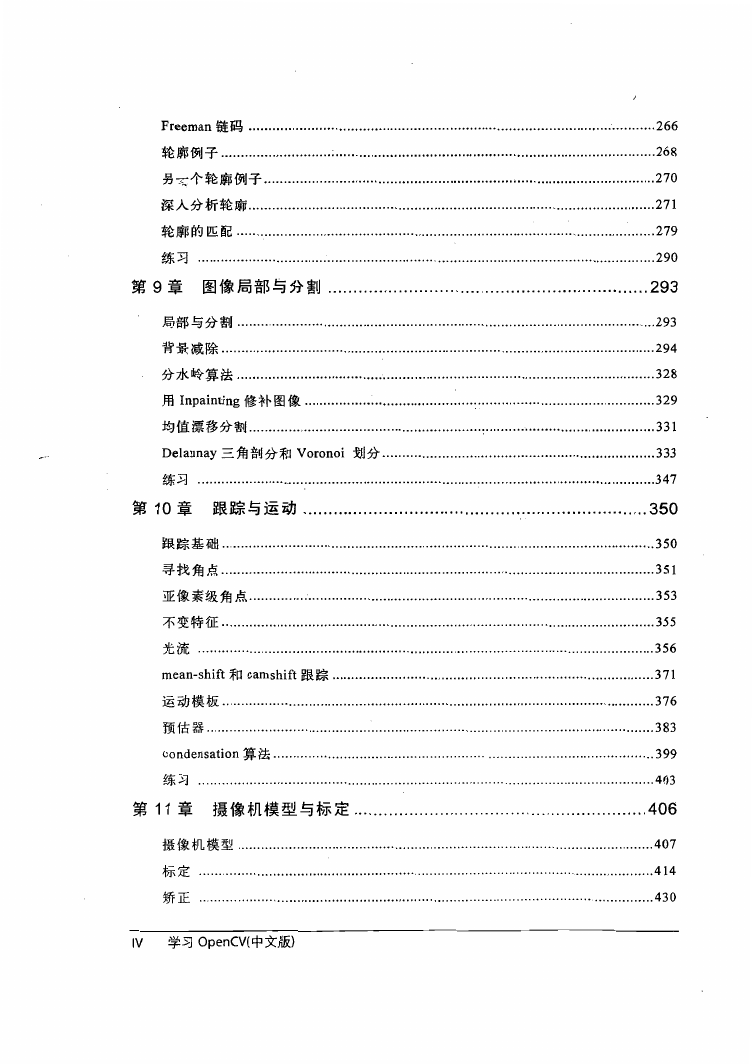








 2023年江西萍乡中考道德与法治真题及答案.doc
2023年江西萍乡中考道德与法治真题及答案.doc 2012年重庆南川中考生物真题及答案.doc
2012年重庆南川中考生物真题及答案.doc 2013年江西师范大学地理学综合及文艺理论基础考研真题.doc
2013年江西师范大学地理学综合及文艺理论基础考研真题.doc 2020年四川甘孜小升初语文真题及答案I卷.doc
2020年四川甘孜小升初语文真题及答案I卷.doc 2020年注册岩土工程师专业基础考试真题及答案.doc
2020年注册岩土工程师专业基础考试真题及答案.doc 2023-2024学年福建省厦门市九年级上学期数学月考试题及答案.doc
2023-2024学年福建省厦门市九年级上学期数学月考试题及答案.doc 2021-2022学年辽宁省沈阳市大东区九年级上学期语文期末试题及答案.doc
2021-2022学年辽宁省沈阳市大东区九年级上学期语文期末试题及答案.doc 2022-2023学年北京东城区初三第一学期物理期末试卷及答案.doc
2022-2023学年北京东城区初三第一学期物理期末试卷及答案.doc 2018上半年江西教师资格初中地理学科知识与教学能力真题及答案.doc
2018上半年江西教师资格初中地理学科知识与教学能力真题及答案.doc 2012年河北国家公务员申论考试真题及答案-省级.doc
2012年河北国家公务员申论考试真题及答案-省级.doc 2020-2021学年江苏省扬州市江都区邵樊片九年级上学期数学第一次质量检测试题及答案.doc
2020-2021学年江苏省扬州市江都区邵樊片九年级上学期数学第一次质量检测试题及答案.doc 2022下半年黑龙江教师资格证中学综合素质真题及答案.doc
2022下半年黑龙江教师资格证中学综合素质真题及答案.doc